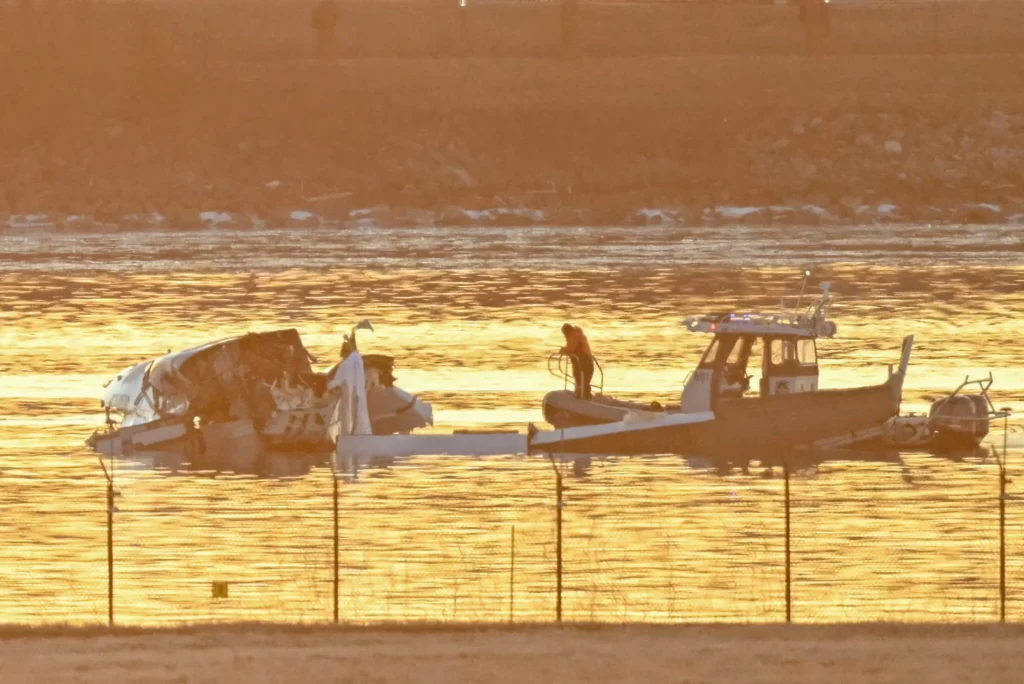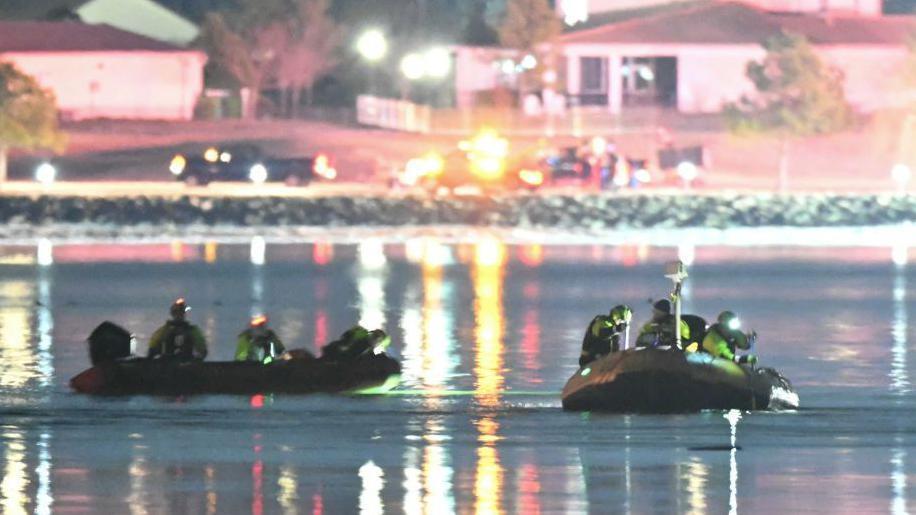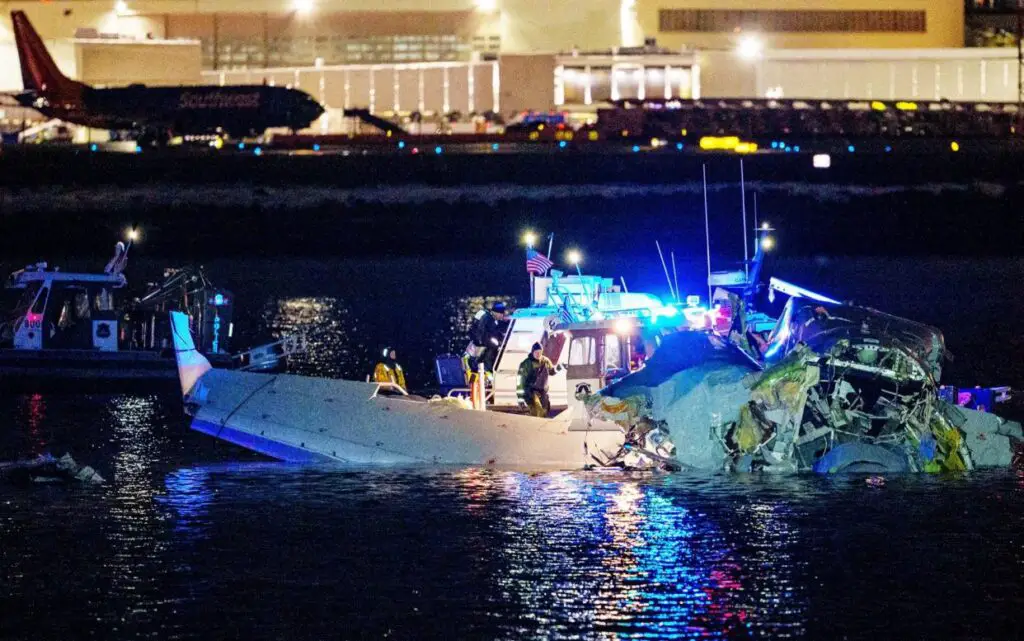In a devastating aviation disaster, a mid-air collision over the Potomac River near Washington, D.C., resulted in the deaths of 67 individuals on the evening of January 29. The accident involved American Eagle Flight 5342, operated by PSA Airlines, and a U.S. Army Black Hawk helicopter. Both aircraft crashed into the river, leading to a large-scale search and recovery operation.

Table of Contents
Tragic Collision Over the Potomac
According to preliminary reports from the Federal Aviation Administration (FAA) and the National Transportation Safety Board (NTSB), the incident took place at approximately 9:00 p.m. local time. American Eagle Flight 5342, en route from Wichita, Kansas, to Ronald Reagan Washington National Airport, was carrying 60 passengers and four crew members. The Black Hawk helicopter, with three military personnel on board, was reportedly conducting routine training exercises.
Eyewitnesses described a horrific scene as the two aircraft collided mid-air, sending debris raining down into the icy waters of the Potomac River. One witness, Mark Stevenson, a local fisherman, recounted, “I saw a bright flash, followed by a loud explosion. Then, parts of the aircraft started falling into the river. It was terrifying.”
Search and Recovery Efforts Underway
Rescue teams, including the U.S. Coast Guard, local police, and emergency responders, were immediately dispatched to the scene. So far, 28 bodies have been recovered from the wreckage, while efforts continue to locate the remaining victims. The recovery operation is being hindered by freezing temperatures and strong currents in the river.
Washington, D.C., Fire and EMS Chief John Donnelly provided an update on the search efforts, stating, “We are working tirelessly to recover all victims and provide closure to their families. This is one of the most challenging recovery operations we’ve undertaken.”
Washington Investigations Underway
The NTSB has launched a formal investigation into the causes of the mid-air collision. While the exact cause remains unknown, initial reports suggest that an air traffic control miscommunication might have played a role. A leaked transcript from the control tower indicates that the Black Hawk’s pilot was asked whether they had the American Airlines jet “in sight” just 30 seconds before impact.
Aviation expert Dr. Richard Collier weighed in on the possible causes, stating, “Mid-air collisions are rare, but when they do happen, they are often due to lapses in communication and situational awareness. The FAA and NTSB will need to closely examine air traffic control procedures and radar data.”

Impact on Air Travel and Security Measures
Following the crash, Ronald Reagan Washington National Airport was temporarily shut down, with flights being diverted to Dulles International Airport and Baltimore/Washington International Airport. Normal operations are expected to resume by the morning of January 30.
In response to the tragedy, aviation authorities are considering stricter regulations regarding military and commercial flight coordination. The FAA has already issued an advisory to all air traffic control centers, urging them to exercise extreme caution when managing military aircraft operations near civilian airspace.
National Response and Political Repercussions
President Donald Trump addressed the nation following the disaster, expressing his condolences to the families of the victims. He called for a full-scale investigation and emphasized the need for enhanced aviation safety measures. “This is a heartbreaking tragedy. We will leave no stone unturned in determining what went wrong and ensuring that such a catastrophe never happens again.”
His response has drawn mixed reactions, with some praising his swift action, while others criticize his handling of aviation safety policies in the past. Political analysts speculate that this incident could have a significant impact on upcoming legislative discussions surrounding air safety regulations.
Mourning the Victims
Families of the victims have begun gathering in Washington, D.C., to identify their loved ones. Vigils are being held across the country, with many lighting candles in memory of those lost in the crash. Social media has been flooded with messages of support and grief, with hashtags like #DCPlaneCrash, #PrayForTheVictims, and #AviationSafety trending worldwide.
One grieving mother, Sarah Matthews, who lost her son in the crash, shared her pain: “He was coming home after months away. I was waiting for his call. Instead, I got the worst news any parent could ever receive.”

Aviation Safety in Focus
This Washington D.C. plane crash incident marks the deadliest air disaster in the U.S. in nearly 24 years and has reignited debates over aviation safety. Experts are urging the government to invest in better radar and communication systems to prevent such tragedies in the future.
Dr. Amanda Foster, an aviation safety specialist, emphasized the importance of improving flight monitoring systems. “We need to implement AI-driven air traffic control monitoring to enhance coordination between commercial and military aircraft. Lives depend on it.”
Moving Forward
As investigations continue, authorities are determined to uncover the factors that led to this catastrophe. The findings of the NTSB and FAA will likely shape future air traffic management policies and contribute to preventing such accidents in the future.
For now, the nation mourns the loss of 67 souls who perished in this tragic mid-air collision. The memories of the victims will remain in the hearts of their families, friends, and the countless lives they touched.
